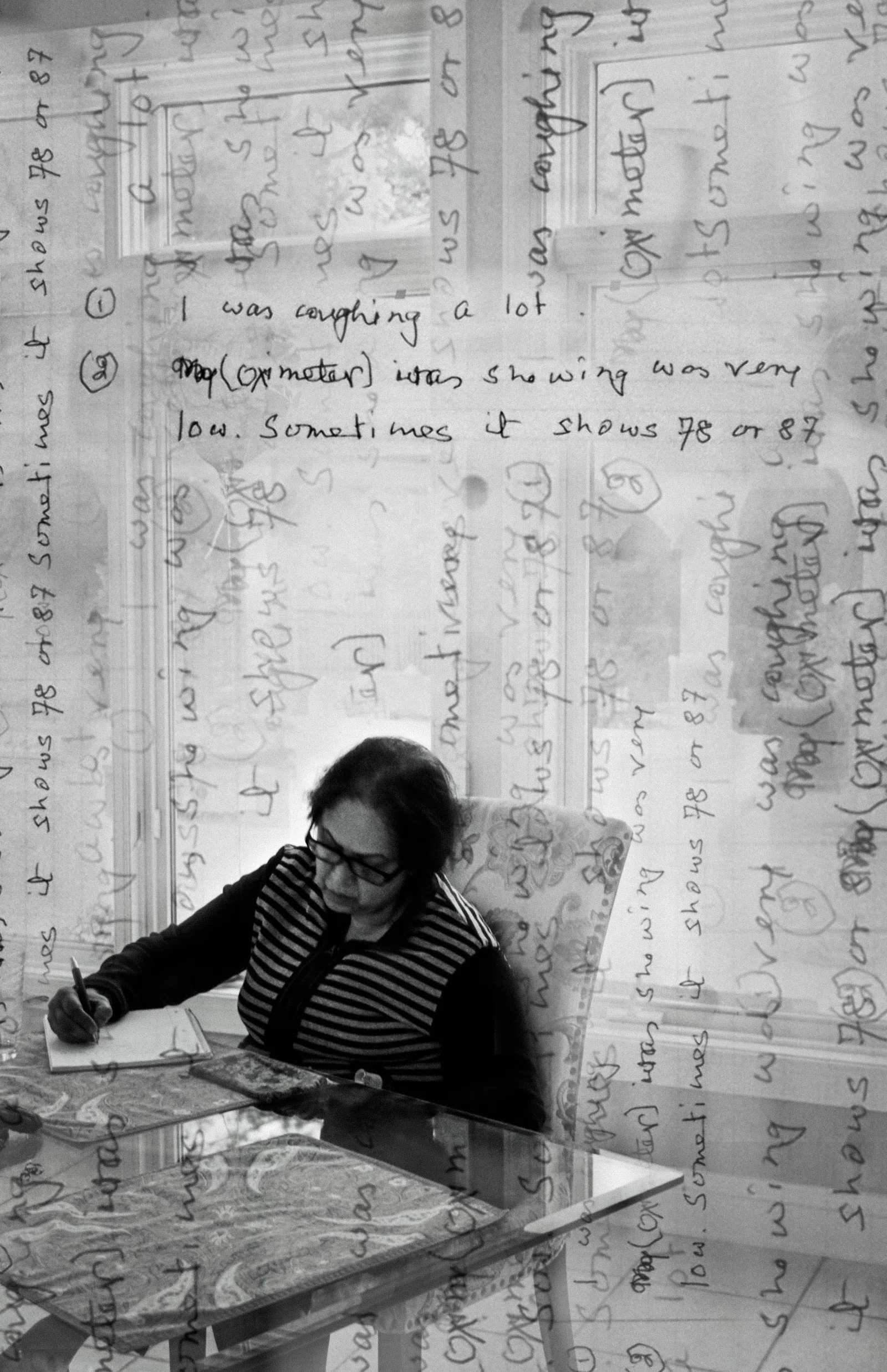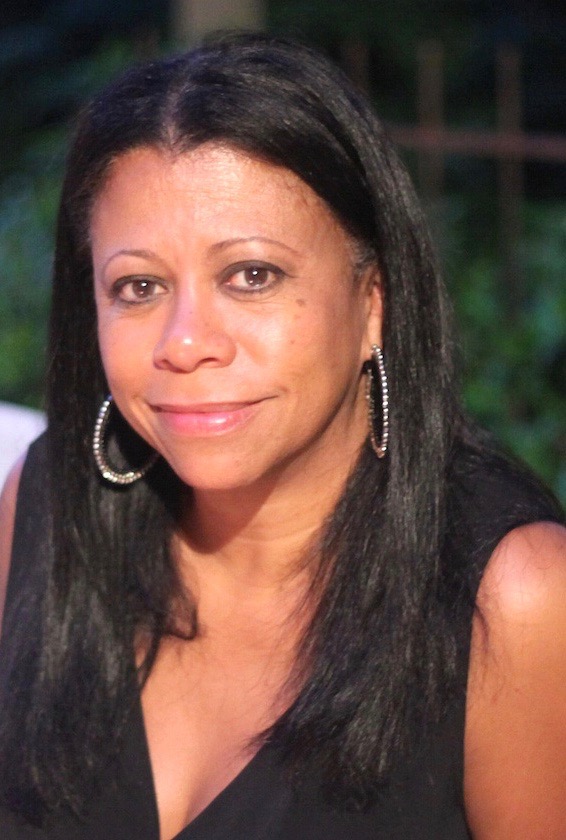







2-D Design
Zaira Chowdhury
Georgetown Day School|Washington, District of Columbia

Choking|10.8 x 7” in.
Material(s): Original composite of photos with a Canon EOS 80D. Edited in Photoshop and Lightroom.
Process(es): She wrote her symptoms for her doctor. Her words were enlarged as a backdrop to create a pattern.
Curatorial Note: Powerful images of watching a family member struggle with a major illness.


In my portfolio, I explore the mental and physical side effects of managing life with a terminal illness. Choking details the subject in an early stage of her illness as she documents her symptoms. The writing, entangled and encompassing the scene, represents her uncertain thoughts as she accepts this illness as her new reality.

Student statement
Student
statement
Creating this portfolio, especially on such a personal and heavy topic, was not an easy task. It took more out of me than I could have ever imagined and made me empathize more than I ever have.
What was also new to me was this style of photography. Coming from a background of mainly landscape and nature photography, taking on this project and desiring to do it well was a considerable amount to undertake. I had to teach myself how to manage Photoshop and Lightroom with the little knowledge I knew, and I had to expand my view on how I can create art. If my idea was not shown correctly, due to my devotion to making a product that was respectful of my family, I had to redo it and revise it with better ideas that shifted its focus. I also needed to dig into a different heavy topic in every one of my pieces and format it in a way that was accurate and respectful to the subject.
None of this would have been conceivable without the constant motivation and support from my teacher Michelle Cobb. She pushed me to explore this topic when I was unsure of my topic and tried to make a portfolio of photos with shadows. She is diligent and detail-oriented with every one of her students, and she pushes them, so they create their best work. She fosters success and expects it from everyone. I hope you are able to speak with her or even be around her once. You will know from that interaction that she would do anything for the people around her.
I would advise future students when forming not only their AP portfolio but any project they may undertake going forward to find meaning in their work. Purpose will drive motivation.
Finally, I would like viewers to understand that this is a representation of an outsider's view of someone else’s situation. This can never correctly capture the moments I aimed to present, even with my full intention to do so. Interpret these images in the way you would like. Thank you for reading and viewing.

Zaira Chowdhury

Alone|7 x 10.8 in.
Material(s): Original iPhone 12 Pro photo edited in photoshop
Process(es): Arial shot taken and subject lightened to add focus to the emotion of loneliness.
Curatorial Note: Powerful images of watching a family member struggle with a major illness.
“Alone depicts the feeling of helplessness the subject feels while by herself in her hospital room. With nothing but the sickness to face, she continues forward despite the apparent toll it is taking on her. In this moment, she is having to sit with the damages of the disease and contemplate her situation. The photo looks down on her from above, in the way a security camera would, to display a true image of what she is facing and how she is surviving it when completely isolated.”
Teacher Statement
Teacher Statement
Michelle Cobb

The AP Art and Design course supports inquiry-based personalized learning in the sustained investigation portfolio component. What strategies helped you guide students through inquiry?
My strategy has been to help students learn how to develop concepts through sketching, research, learning from other artists, and willingness to experiment. Work ethic is also a very important part of success in this course. Zaira's goal was to document the end of her grandmother's life respectfully without her intentions or methods being too obvious. However, she had challenges because the subject was so close to her.
How did you scaffold writing into the artmaking and thinking processes?
Teaching students how to explain their work and how it relates to the Inquiry was definitely the hardest part! Sometimes the work needed to be developed first, and sometimes, the writing needed to be developed first. Journaling was critical. In Zaira’s case, the writing was difficult because her inquiry was about her grandmother’s terminal illness, and we had to stop and unpack her feelings in response to documenting her loved one’s end-of-life journey.
How did you support skill development AND inquiry in the AP Art and Design curriculum?
We had a lot of one on one discussions to process her feelings and observations. Although Zaira is a photographer, I discovered she was also a talented multimedia artist, and I encouraged her to go outside the confines of photography to explore her story. In the end, because it was so emotional, I wanted Zaira to pay tribute to her grandmother’s life while she was alive. She did this in a beautiful collage using artifacts, news clippings, and actual photos chronicling her life.
How did you structure practice, experimentation, and revision into your AP Art and Design
curriculum?
I encourage my students to focus on the journey, which deals with practice, experimentation, and revision. If they were not exploring this part of the curriculum, I would not allow them to progress without a deeper dive into more research and experimentation with different materials. My teaching practice is also based on “Standing on the Shoulders of Giants.” My students must learn about other artist and their processes.
What formative and summative assessments helped guide your students through your AP Art
and Design curriculum?
Weekly group and individual critiques concluding with constructive ideas were very important. Students get “stuck” sometimes and need help in moving forward. I often invited professional artists to give additional feedback, which might even be different from mine. This allowed for objective critiques and new ideas. Also, reviewing the AP rubrics kept them on a clear path to the objectives.
What kind of creative programming (i.e., exhibit spaces, mentoring programs, curricular
supports) have you implemented to support AP Art and Design students?
We have a wonderful gallery space where students exhibit all of their new work. Mentoring involves exposing them to successful practicing artists, including alumni, local artists, or other judges/competitions. In addition, my students also know that I am always available for support and feedback. They might send me work over a weekend or a holiday, and I do my best to respond regularly to keep the ball rolling.
What did you learn from working with this student?
I learned that Zaira is a very deep thinker who is not always confident in how to convey her ideas. When challenged, she opens up and reveals her abilities. She often underestimated what she was capable of. She has a natural eye for design and is willing to take risks. Her focus is not on the end product but on the creation experience. She is a kind, hardworking and thoughtful student.
Is there anything your school principal does to support your art students or art program?
Our principal and administration fully support our studio art program and provides the resources we need for our creative environment.
What is your advice to other AP Art and Design teachers?
It is really important to develop strong relationships with students—I understand before they do what their potential is. There must be a development of trust between you and the student so they can feel safe, vulnerable, and open to experimentation with their work. However, so much of the early stages of the art stem from fear. With trust, students can overcome these fears and obstacles that prevent them from reaching their fullest potential. The AP curriculum provides this perfect combination of challenge and an opportunity for students to create their best work.














